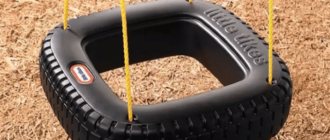Differences between concrete mixers by type of action
Having found out about the mechanism of operation of concrete mixers and their parameters, you will be able to choose the right design for a particular construction site. You don’t have to make your work difficult if you can use a simple mechanical device.
In addition, if you load the concrete mixer to the very top, it will not be possible to complete pouring the foundation faster, as this will cause overload of the motor and rapid breakdown.
When choosing the design of an apparatus for mixing a solution, you need to take into account the principle of its operation:
- Mechanical models. Driven by hand crank. When it is necessary to mix a large amount of concrete, you will need two people to rotate the handle;
- Electric options. They operate from the mains, and connecting the motor will require good knowledge of auto mechanics.
At what speed should I mix concrete?
We will not consider in detail the process of mixing concrete - this is the topic of a separate article. Let us only note the fact that the torsional moment plays an important role.
This is why the washer gearbox is better than a regular motor from a scooter or car. It can withstand almost any load and can operate at low speeds. 25 full cycles (revolutions) per minute is enough.
To provide this quantity, the gearbox can have a different design. The simplest, most typical option is when the gearbox is made of a belt and pulley. A do-it-yourself concrete mixer with a moped motor is distinguished by its mobility. The gearbox is convenient and compact; it does not require electricity to operate. Even if you have a large area, the made device moves around it without unnecessary worries and hassle.
The gearbox in this case must be chain, otherwise the design will not function well.
Drawings of a concrete mixer video
Manual and electric models
When there are 2-3 strong people at the construction site, it is possible to settle on a handmade product. The components of the mixture are immersed together or one by one.
One disadvantage of a design with a moving barrel, rather than a shaft moving in the middle, is the inability to add water while mixing.
- You will need to stop the barrel, open the hatch and add water. The hatch is screwed in and mixing of the mixture continues.
- Electrically powered concrete mixers make it possible to mix large volumes of mortar in a short time.
- The work process can easily be controlled by one person.
It should be taken into account that high-power motors require a three-phase line, so when selecting the capacity of the tank, you need to calculate the motor power in advance. If a 220 volt line is connected to the site, then it will not be possible to create heavy solutions.
Preparation of drawings
The selected container must be displayed to scale on paper. All calculations and dimensions must be transferred to the plan diagram. The location of the frame stand, the barrel itself and additional fittings (mounts, rotating mechanisms, motor with a protective shield) are also displayed there.
If you lack artistic skills, you can always use ready-made plans for various models of concrete mixers.
Note!
DIY vices: simple and reliable homemade vices from A to Z (190 photos)Do-it-yourself vibrating table - selection of materials, components and assemblies for a vibrating table with a step-by-step manufacturing description
Do-it-yourself grain crusher - operating principle, types and features of creating a device for processing grain crops
Variety of options
Apparatuses for mixing concrete are divided according to the principle of operation, and from this the type of construction emerges:
- Compulsory products. They are characterized by a stationary container in which blades mounted on a shaft rotate.
- Gravity models. The concrete is mixed by rotating the container, in which the blades are attached to the walls.
- Vibration options. They do not have great productivity, but they provide a high-quality and homogeneous mixture without air bubbles.
- Periodic species. They are characterized by low power, so they require frequent stops. For private construction this is an acceptable option.
- Gear or crown type.
- Permanent action. These concrete mixers work without interruption and are used for large volumes of work.
All of the above types of concrete mixers come in both mechanical and electric models. The difference is that a forced-action mechanical stirrer has a horizontal axis, while an electric one can accommodate a vertical axis.
The design of any concrete mixer allows you to evenly mix cement with different components in the form of: gravel, sand, crushed stone, expanded clay with water. Due to this, the pace of construction is greatly increasing.
Design selection
Depending on the amount of work being carried out and the parts available, you can do:
Manufacturing Guide
- Preparation of all elements, container and frame, marking of fasteners.
- Frame assembly.
- Installation of the barrel.
- Fixing the motor and gearbox in one plane, installing protection against splashes of the solution.
Basic nuances and recommendations
To do everything right, it is additionally important:
It is important that the tool you make meets all necessary safety requirements. Homemade devices should not cause harm.
What is a concrete mixer made of?
Many people are interested in the question: what can a concrete mixer be made from? Let's take a closer look at this issue, taking into account the available products: barrels, cans, you will also need pipe cuttings and other scrap metal, which will be useful in creating a homemade concrete mixer.
Old washing machine
A self-made concrete mixer from a washing machine is used quite successfully in practice. Over the past two decades, home appliance manufacturers have used fairly durable materials as machine drums.
They only require additional treatment with an anti-corrosion compound and periodic inspections for the appearance of rust on the inner surface.
Making from a barrel
This design has an unusual line of movement. In it, the rotation axis passes obliquely through the container. Therefore, the solution in it turns over from one wall to another. The design is simple and effective.
The important thing is that there are no difficulties with welding joints of different types of metal.
Consists of elements:
- Metal barrel;
- Base made of metal corner;
- Pipe shaft;
- Bearings;
- Handle with handle;
- Manhole cover;
- Locks, seals.
In the upper section of the frame, bearings are mounted in the center, into which the handle is threaded. Thanks to them, a 200 liter barrel rotates with ease.
It is advised to select a barrel with thicker walls, then it will last longer.
- In the middle, the additional blades are not welded: they are able to hold the ingredients, preventing mixing and making unloading difficult.
- The device contains a loading hatch in the bottom.
- This is a section cut off by 1/3, secured with loops to the bottom, equipped with a sealing elastic band along the plane and closed with 2 locks.
- To load the barrel, turn it in such a position so that the hatch is on top.
- For unloading, it turns with the hatch down.
- The solution itself is dumped into the container located below, and the adhering material is removed by hitting the barrel with a sledgehammer.
Four Principles of Mixing Concrete
Homemade concrete mixer
According to the facts, you can prepare your own solution without special equipment. Many people even like to work “according to the old method.” But how much do you manage to do this way? It is still possible to create a dry mixture for construction using a conventional drill or mixer. But when it comes to sand and cement, they are powerless.
The simplest and most common mixing principle is called forced. All components are mixed in a container that is stationary. A mechanical drive is usually used for this. The working drum can be positioned vertically or horizontally.
Drawing of a horizontal concrete mixer
Despite the fact that even a small forced-action concrete mixer can be very effective, it also has its disadvantages:
- “Dead zones” appear in the container. This especially applies to the space near the walls.
- Complexity of design. Rotation units must be hermetically protected from the effects of the solution, which may be aggressive.
- It is almost impossible to prepare a solution in such a unit, which includes medium and large filler.
The second principle is called gravitational. In this case, all components are mixed due to gravity. In industry, this method is rarely used, as it requires a lot of time and effort. Barrels made of metal are most often used as containers. How they are made and how to make a stand will be discussed below.
Most modern concrete mixers use a combined principle that combines the first two methods. They have the following advantages:
- Strict sealing is not necessary. The drum is open at the top; there is no need for rotation units, since any contact with the solution is excluded.
- Parts wear out much less frequently.
- Simplicity and reliability of operation.
- There are also no restrictions on the composition of the solution - it can be crushed stone, expanded clay, gravel, and so on.
The fourth principle of mixing is called vibrational. Recently, some craftsmen have been mixing the solution using vibration. If we talk about large-scale volumes, the results can be the most stunning. Typically, the vibration mixing principle is used when it is necessary to produce a precise reinforced concrete structure with good performance characteristics.
We also recommend reading
- Do-it-yourself grill from a gas cylinder
- Firewood - luxury or necessity
Under normal conditions, the gearbox and drive are replaced by a powerful hammer drill (permissible minimum 1.3 kW). Its vibration action must be independent. There is no need to press the cartridge.
Concrete mixer gearbox photo
In general, vibration mixing allows you to create an almost perfect concrete mixture. However, it is also not optimal for preparing a “heavy” solution.
Making from a milk can
A simple manual concrete mixer can be made from the usual metal flask in which milk was sold. You will also need to cut pipes and metal. The design is simple and such an apparatus for mixing concrete can be made in 2 hours, the main thing is to weld the frame.
It will take 20-30 minutes to assemble the concrete mixer structure.
The steps for the work stages are as follows:
- The bed is prepared, a handle is bent from a round pipe.
- In the upper half of the frame, two couplings from the water supply are welded. Their internal diameter should be slightly larger than the cross-section of the tube.
- The pipe is pulled through the flask and welded to the body.
- In order for the barrel to spin easily, you need to find the center of gravity. To do this, you need to put it on some object and move it back and forth to determine this center. A handle stretches through it.
- By extending the handle, it is then attached to the walls of the case. Difficulties may arise here due to the fact that the barrels are made of aluminum and the handle is made of steel. It will not be possible to combine them by welding. An accessible solution is to do cold welding. It's really applicable. Another option is to weld plates onto the handle, which can then be riveted to the sides of the can.
- To prevent large play of the handle, nuts are welded to it on both sides of the coupling.
At this stage, the design is ready for use. 1 mixing in a 40 liter can can yield 2.5-3 buckets of solution. For use on a summer cottage or near a private house, without construction, this is quite enough.
Common mistakes
During the manufacturing process of this device, a number of errors may occur that must be foreseen in advance and, if possible, prevented:
Any craftsman can always save a decent amount of money if he knows how to make a concrete mixer with his own hands. Besides, it’s not that difficult to do.
It is enough to have a minimum of building materials, tools, resourcefulness and attention.
Kawabanga! Estimate for installation of asphalt concrete pavements
In addition, no matter what the concrete mixer is made of, it can serve you for a long time with proper care and proper design.
It is better to start construction with two or three people. One person will not be able to cope with the amount of work that will need to be done at one time.
It is important that the tool you make meets all necessary safety requirements. Homemade devices should not cause harm.
Photo of a homemade concrete mixer
Disadvantages of use
- For electrical appliances, this is the opening of the hatch some time after the power supply has stopped and, as a result, the discharge of concrete (otherwise it will harden).
- In addition, concrete mixers are, in principle, seasonal. For the most part, they (especially small units) cannot be used at sub-zero temperatures. As a result, in winter it is necessary to additionally use a steam generator.
- Separately, it is worth highlighting the disadvantages of motor-driven devices - the high cost of the fuel used, the high noise level during operation, as well as the toxicity of the exhaust.
- A simple mortar mixer, capable of operating at a temperature not lower than +2 degrees, does not have equipment that ensures heating of the mixture.
- The productivity of manual units is quite low, while the labor intensity of mixing, on the contrary, is high.











